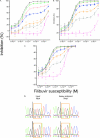Characterization of resistance to the nonnucleoside NS5B inhibitor filibuvir in hepatitis C virus-infected patients
- PMID: 22203605
- PMCID: PMC3294886
- DOI: 10.1128/AAC.05611-11
Characterization of resistance to the nonnucleoside NS5B inhibitor filibuvir in hepatitis C virus-infected patients
Abstract
Filibuvir (PF-00868554) is an investigational nonnucleoside inhibitor of the hepatitis C virus (HCV) nonstructural 5B (NS5B) RNA-dependent RNA polymerase currently in development for treating chronic HCV infection. The aim of this study was to characterize the selection of filibuvir-resistant variants in HCV-infected individuals receiving filibuvir as short (3- to 10-day) monotherapy. We identified amino acid M423 as the primary site of mutation arising upon filibuvir dosing. Through bulk cloning of clinical NS5B sequences into a transient-replicon system, and supported by site-directed mutagenesis of the Con1 replicon, we confirmed that mutations M423I/T/V mediate phenotypic resistance. Selection in patients of an NS5B mutation at M423 was associated with a reduced replicative capacity in vitro relative to the pretherapy sequence; consistent with this, reversion to wild-type M423 was observed in the majority of patients following therapy cessation. Mutations at NS5B residues R422 and M426 were detected in a small number of patients at baseline or the end of therapy and also mediate reductions in filibuvir susceptibility, suggesting these are rare but clinically relevant alternative resistance pathways. Amino acid variants at position M423 in HCV NS5B polymerase are the preferred pathway for selection of viral resistance to filibuvir in vivo.
Figures




Similar articles
-
Clinical and in vitro resistance to GS-9669, a thumb site II nonnucleoside inhibitor of the hepatitis C virus NS5B polymerase.Antimicrob Agents Chemother. 2014 Nov;58(11):6599-606. doi: 10.1128/AAC.02815-14. Epub 2014 Aug 25. Antimicrob Agents Chemother. 2014. PMID: 25155588 Free PMC article. Clinical Trial.
-
Hepatitis C virus RNA elimination and development of resistance in replicon cells treated with BMS-790052.Antimicrob Agents Chemother. 2012 Mar;56(3):1350-8. doi: 10.1128/AAC.05977-11. Epub 2012 Jan 3. Antimicrob Agents Chemother. 2012. PMID: 22214777 Free PMC article.
-
Genotypic and phenotypic analyses of hepatitis C virus variants observed in clinical studies of VX-222, a nonnucleoside NS5B polymerase inhibitor.Antimicrob Agents Chemother. 2014 Sep;58(9):5456-65. doi: 10.1128/AAC.03052-14. Epub 2014 Jun 30. Antimicrob Agents Chemother. 2014. PMID: 24982088 Free PMC article. Clinical Trial.
-
Filibuvir, a non-nucleoside NS5B polymerase inhibitor for the potential oral treatment of chronic HCV infection.IDrugs. 2010 Dec;13(12):938-48. IDrugs. 2010. PMID: 21154154 Review.
-
Hepatitis C virus resistance to protease inhibitors.J Hepatol. 2011 Jul;55(1):192-206. doi: 10.1016/j.jhep.2011.01.011. Epub 2011 Feb 1. J Hepatol. 2011. PMID: 21284949 Review.
Cited by
-
Clinical and in vitro resistance to GS-9669, a thumb site II nonnucleoside inhibitor of the hepatitis C virus NS5B polymerase.Antimicrob Agents Chemother. 2014 Nov;58(11):6599-606. doi: 10.1128/AAC.02815-14. Epub 2014 Aug 25. Antimicrob Agents Chemother. 2014. PMID: 25155588 Free PMC article. Clinical Trial.
-
Hepatitis C virus variants with decreased sensitivity to direct-acting antivirals (DAAs) were rarely observed in DAA-naive patients prior to treatment.J Virol. 2013 Feb;87(3):1544-53. doi: 10.1128/JVI.02294-12. Epub 2012 Nov 14. J Virol. 2013. PMID: 23152524 Free PMC article.
-
Discovery of a novel series of potent non-nucleoside inhibitors of hepatitis C virus NS5B.J Med Chem. 2013 Oct 24;56(20):8163-82. doi: 10.1021/jm401266k. Epub 2013 Oct 10. J Med Chem. 2013. PMID: 24069953 Free PMC article.
-
Hepatitis C virus genetic variability and the presence of NS5B resistance-associated mutations as natural polymorphisms in selected genotypes could affect the response to NS5B inhibitors.Antimicrob Agents Chemother. 2014 May;58(5):2781-97. doi: 10.1128/AAC.02386-13. Epub 2014 Mar 3. Antimicrob Agents Chemother. 2014. PMID: 24590484 Free PMC article.
-
Naturally occurring resistance mutations to inhibitors of HCV NS5A region and NS5B polymerase in DAA treatment-naïve patients.Virol J. 2013 Dec 17;10:355. doi: 10.1186/1743-422X-10-355. Virol J. 2013. PMID: 24341898 Free PMC article.
References
-
- Cooper C, et al. 2009. Evaluation of VCH-759 monotherapy in hepatitis C infection. J. Hepatol. 51:39–46 - PubMed
-
- Fried MW, et al. 2002. Peginterferon alfa-2a plus ribavirin for chronic hepatitis C virus infection. N. Engl. J. Med. 347:975–982 - PubMed
-
- Gaudieri S, et al. 2009. Hepatitis C virus drug resistance and immune-driven adaptations: relevance to new antiviral therapy. Hepatology 49:1069–1082 - PubMed
-
- Graham EJ, et al. 2011. Colony-forming assays reveal enhanced suppression of hepatitis C virus replication using combinations of direct-acting antivirals. J. Virol. Methods 174:153–157 - PubMed
Publication types
MeSH terms
Substances
LinkOut - more resources
Full Text Sources

